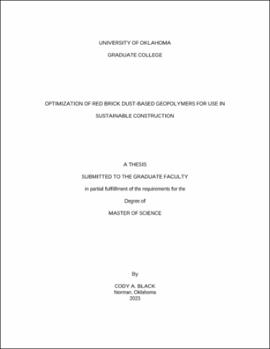| dc.description.abstract | With the rising carbon dioxide levels affecting climate change, sustainable and eco-friendly alternatives to ordinary portland cement (OPC) are being investigated. To reduce the overall environmental impact, industrial waste products, such as fly ash and silica fume, have been used as partial substitutions for OPC in modern concrete mix designs. Other waste products can be used as replacements, and one such waste product is red brick dust (RBD). This research seeks to repurpose processed RBD through the utilization of geopolymerization processes. Geopolymerization utilizes alkali activators, which cause the low-reactive RBD to interact more readily with its constituent parts to form a strong geopolymer base. Ground limestone, calcium hydroxide, and alumina were chosen and added to facilitate a stronger geopolymer reaction from the aluminosilicate. An extensive literature review was performed to understand the underlying principles and establish target ratios for the molar values of components. These target ratios were calculated based on the quantities of raw materials and alkali activators after converting to moles of calcium, silica, or alumina. Afterwards, each component was weighed based on content requirements, followed by modifications to the RBD geopolymer mixture using substitution by weight percent of RBD. Multiple mix designs were used, along with ambient and oven curing methods, to determine an optimized region in which RBD geopolymers showed the highest compressive strength. Uniaxial compressive testing and calorimetry reports allowed for the identification of strength properties and gel phases, respectively. Once the data was analyzed for the 2”x2” mortar cubes, the initial approach of Ancient Roman concrete mimicry changed to hybrid gel formation for the 3”x6” cylinder series. Compressive strength results were overlayed onto ternary diagrams, and a maximum compressive strength zone was identified. Seven-day ambient-cured, 28-day ambient-cured, and oven-cured compressive strengths were analyzed against ACI codes to establish compressive strength limits and achieve the goal of this research: to find a sustainable alternative to OPC with improved or similar material characteristics through the optimization of low-reactive aluminosilicates and geopolymerization techniques. | en_US |

